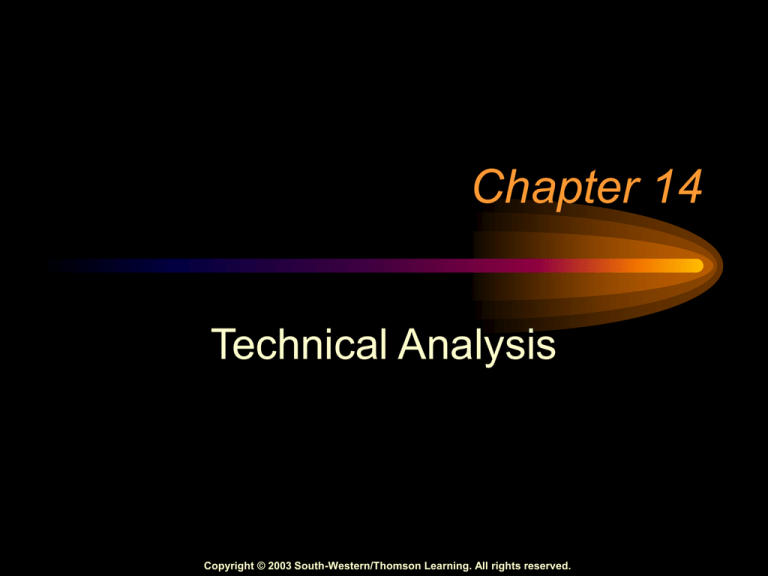
Chapter 14
Technical Analysis
Copyright © 2003 South-Western/Thomson Learning. All rights reserved.
The Technique
• Uses historical price and volume
data to forecast the direction of
stock prices
• Employs a variety of figures and
charts
• The indicators can be applied to
– the market
– to individual firms
Copyright © 2003 South-Western/Thomson Learning. All rights reserved.
The Dow Theory
• Emphasizes movements in the
industrial and transportation
averages
• Movement in one average
confirmed by movement in the
other average indicates a trend
Copyright © 2003 South-Western/Thomson Learning. All rights reserved.
Barron’s Confidence Index
• An indicator based on the
difference in the yields paid by
– high-quality debt and
– low-quality debt
• Increased spread is bearish
Copyright © 2003 South-Western/Thomson Learning. All rights reserved.
Purchases and
Sales of Odd Lots
• Based on small investors being
wrong
• Increases in odd lot purchases are
interpreted as being bearish
• Increases in odd lot sales are
interpreted as being bullish
Copyright © 2003 South-Western/Thomson Learning. All rights reserved.
Investment Advisory Opinions
• A variation on the odd lot theory
–assumes advisory opinions are
wrong
–requires taking a contrary view of
advisory opinions
Copyright © 2003 South-Western/Thomson Learning. All rights reserved.
Advance / Declines
• Tracks cumulative net advances
(the difference between advancing
and declining stocks)
• Increase in cumulative net
advances is bullish
Copyright © 2003 South-Western/Thomson Learning. All rights reserved.
Point-and-Figure Charts
• Identifies price levels that support
or resist price changes
• Breaking support or resistance
levels are buy and sell signals
Copyright © 2003 South-Western/Thomson Learning. All rights reserved.
Point-and-Figure Charts
Copyright © 2003 South-Western/Thomson Learning. All rights reserved.
Bar Graphs
(and Candlesticks)
• Show similar patterns as point-andfigure charts
• Use support and resistance
• Give similar signals
Copyright © 2003 South-Western/Thomson Learning. All rights reserved.
Bar Graphs
(and Candlesticks)
Copyright © 2003 South-Western/Thomson Learning. All rights reserved.
Moving Averages
• Compare the stock's current price
to a moving average of the stock's
price
• Moving averages may be 50, 100,
or 200 days
• The moving average follows the
current price
Copyright © 2003 South-Western/Thomson Learning. All rights reserved.
Moving Averages
• When the current price crosses the
moving average, that is a buy or
sell signal
Copyright © 2003 South-Western/Thomson Learning. All rights reserved.
Moving Averages
Copyright © 2003 South-Western/Thomson Learning. All rights reserved.
Other Technical Indicators
• Volume
• Short sales by specialists
Copyright © 2003 South-Western/Thomson Learning. All rights reserved.
Verification of
Technical Analysis
• Weak form of the efficient market
hypothesis
–technical analysis does not lead
to superior investment results
• Most empirical results do not
support technical analysis
Copyright © 2003 South-Western/Thomson Learning. All rights reserved.
Verification of
Technical Analysis
• The question of covering the
transaction costs
• May supplement fundamental
analysis of financial statements
Copyright © 2003 South-Western/Thomson Learning. All rights reserved.
The Dogs of the Dow
• Determine the ten Dow stocks with
the highest dividend yield
–hold these stocks for one year
–repeat the process
Copyright © 2003 South-Western/Thomson Learning. All rights reserved.
The Dogs of the Dow
• “Small dogs” applies the same
strategy to the five lowest priced
Dow Dogs
Copyright © 2003 South-Western/Thomson Learning. All rights reserved.







